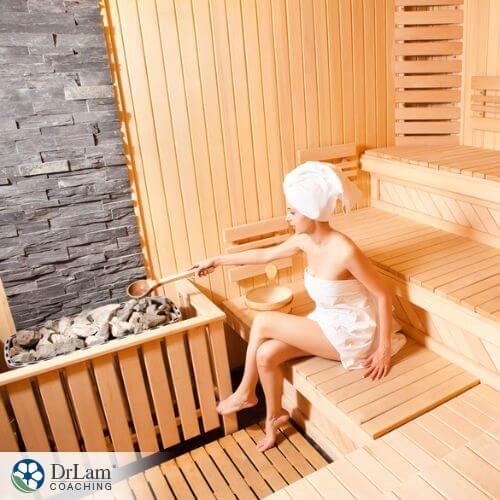 Saunas have been used for centuries to recover from daily stresses and to help cure many illnesses. A sauna is a wet or dry room heated to a very high temperature to induce sweating. This can also help the body detoxify, along with various other benefits. However, there are also some risks associated with sauna use. This article will explore both sauna benefits and dangers.
Saunas have been used for centuries to recover from daily stresses and to help cure many illnesses. A sauna is a wet or dry room heated to a very high temperature to induce sweating. This can also help the body detoxify, along with various other benefits. However, there are also some risks associated with sauna use. This article will explore both sauna benefits and dangers.
A sauna is a small room with a heater that creates heat and humidity. The heat from the heater increases your heart rate and causes your body to sweat. Saunas are part of a larger category of heat therapy. This type of therapy comes in many variations, including hot packs, heating pads, and hot tubs. Technically, saunas use dry heat, although, in practice, many moist-heat rooms are also called saunas.
There are many different types of sauna. These include the following:
Electrically heated saunas have electric heaters that allow the room to reach higher temperatures quicker and usually contain safety features that can automatically stop the heat after a certain period.
Wood-burning saunas use a stove to heat the room or sauna rocks. It is one of the oldest forms of saunas. However, it's hard to control the temperature and there needs to be a vent system to let out the smoke.
Far-infrared saunas use light to create heat specifically on the body. Unique lamps use light waves and electromagnetic radiation to heat target body areas. Temperatures are typically lower than in other saunas, but people sweat similarly. Usually, these saunas reach around 120F to 140F.
Steam rooms are technically not saunas, but they are often called saunas anyway. They are often found in gyms and spas. These rooms generate steam because of the high humidity levels inside, causing people to sweat easily.
Many people use saunas to reduce stress, increase circulation, detoxify their bodies, and relax. If you're stressed, suffer from chronic pain, or have detox problems, a sauna can be a great way to relieve these symptoms. The sauna's heat loosens up tense muscles and allows them to release any toxins built up in your system.
Sitting in a sauna increases your heart rate and dilates blood vessels. This increase in circulation gives you the same benefits as low to moderate exercise, depending on how long you keep sitting there. Overall, saunas can help many conditions, including the following:
Some people with asthma may find relief by using a sauna. A sauna might help open airways and loosen phlegm. However, if you are on medication for asthma, you should talk to your doctor before using a sauna.
Sauna heat can promote relaxation and feelings of well-being. This is why many people use saunas.
Sauna use may improve cardiovascular health. One study found people who use a sauna regularly may have lower chances of experiencing severe heart-related problems like coronary artery disease and sudden cardiac death.
 A dry sauna decreases the moisture in your skin during use, and some people with psoriasis may find that it reduces their symptoms. However, those with atopic dermatitis might experience worsening of the condition.
A dry sauna decreases the moisture in your skin during use, and some people with psoriasis may find that it reduces their symptoms. However, those with atopic dermatitis might experience worsening of the condition.
A recent study found that using a dry sauna can help the blood vessels relax and dilate, which increases blood flow. This may help those with chronic pain or arthritis, as it could improve pain, stiffness, and fatigue over time.
Sweating is a great way to release toxins. The increased blood flow can help clear toxins and flush out the extracellular matrix as well. However, you have to beware of overdoing it if you have adrenal fatigue, as too rapid of a detox could cause a retoxification reaction, releasing more toxins than your body can process.
One long-term study from Finland found that men who used a sauna frequently had a lower risk of Alzheimer's and dementia than their colleagues. More research is needed to determine why.
Like any other form of heat therapy, there are numerous sauna benefits and dangers. However, with proper precautions, you can minimize this danger.
Here are some sauna dangers:
Dehydration can come from fluid loss due to sweating. Those with certain conditions, like kidney disease, may be at a higher risk of dehydration. It can also lead to dizziness and nausea in some people. If you find yourself dehydrated during your sauna session, drink more fluids to stay hydrated.
Since the point of a sauna is to heat you up to make you sweat, it makes sense that many people end up feeling too hot in a sauna. It's just a sign you may be done or need a break. Remember to stay hydrated and take breaks if you feel too hot or start to sweat profusely. You may also consider wearing less clothing while in a sauna to avoid overheating.
Switching between a sauna and cold water in the pool can increase your blood pressure. Saunas can also cause low blood pressure. So if you have high or low blood pressure, you should probably talk to your doctor before using a sauna.
If you are interested in trying a sauna but are concerned about sauna benefits and dangers, consider following these precautions to keep you safe:
Those who are ill should not use a sauna; you must wait until you have recovered before doing so. Women who are pregnant or those with certain medical conditions like low blood pressure should ask their doctor before using it.
When using a sauna for the first time, spend only 5-10 minutes in the heat. As you get used to the heat, gradually increase your stay up to 20 minutes.
Saunas are a great way to detoxify, but one should not forget that they also cause dehydration. Drink at least 2-4 glasses of water after using the sauna to replace fluids lost from sweating.
Alcohol can increase your risk of dehydration, dangerous changes in blood pressure, cardiac problems, and sudden death after sauna use.
 The heat from a sauna can be addictive, and if you overdo it, your sweat glands may not have enough time to produce the necessary amount of sweat to cool down. Be sure to take regular breaks when you are in a sauna, cooling down in a moderate temperature area.
The heat from a sauna can be addictive, and if you overdo it, your sweat glands may not have enough time to produce the necessary amount of sweat to cool down. Be sure to take regular breaks when you are in a sauna, cooling down in a moderate temperature area.
Retoxification happens after detoxing when your body is unable to fully clear the toxins that are pulled out of the organs. Retox reactions are more severe than detox reactions and can happen in healthy people. Retoxification reactions often happen because of extracellular matrix (ECM) congestion, that is, when you already have toxins in the fluid between cells.
A sauna is one good example of a detoxifier that uses hot temperatures - with heat, blood vessels tend to open, and toxins release from sweating. However, it can also increase the toxic load in the bloodstream, and if not properly passed outside of the body, these toxins can continue to circulate and lead to an exhausted state that can last a few hours or even longer. For those sensitive to heat, even a few minutes in a sauna may be too much.
While saunas generally seem to be safe for people with mostly stable heart disease and even those who have a mild risk for heart failure, there are other people who should not use saunas. If you have angina, chest pain, or low or high blood pressure saunas can cause dangerous cardiac arrhythmias, sudden blood pressure drops, and even death.
If you want to use a sauna, first work your way up, starting at 5 minutes. Immediately leave if you feel dizzy, unwell, or develop a headache while in the sauna. Try not to go directly into cold water or cold air, resting instead somewhere with a moderate temperature. And be sure to talk to your doctor before trying a sauna if you have any kind of heart or blood pressure issue.
We are constantly fighting an endless battle with the ever-present poisons in our environment. It is commonly known the more toxins we accumulate, the faster we age. An abundance of toxins can impair liver function, delay healing processes and trigger Adrenal Fatigue Syndrome (AFS). This is why detoxifications have become popular.
People have known since ancient times that we must remove toxins from our bodies. Each culture has its way of purging the body's organs and blood from those harmful substances.
AFS interferes with the hypothalamus' ability to regulate temperature, so those who have it may feel more overheated when they go into a sauna or hot bath. AFS not only causes discomfort due to high temperatures in bathing situations. In the advanced stages of adrenal fatigue, people can experience dizziness and low blood pressure. Drinking more water is one way to help avoid these symptoms, but if you have low blood pressure, you should still avoid saunas.
When it comes to detoxification, the sauna is an excellent modality. However, the risks are more significant if you don't know what the sauna benefits and dangers are. With heat (when your body's temperature rises), blood vessels tend to dilate, and toxins become more mobile in your body as you sweat.
 The problem with that is that sometimes you cannot release these toxins outside of your body, and they recirculate inside them instead, which can cause stress on joints or brain fog, for example. We refer to this as "retoxification." With more retoxification, the body becomes weaker, and it is harder to recover from AFS. What's important about using a sauna responsibly is not to do so during the advanced stages of AFS because it can trigger adrenal crashes from too much detoxifying going on at once.
The problem with that is that sometimes you cannot release these toxins outside of your body, and they recirculate inside them instead, which can cause stress on joints or brain fog, for example. We refer to this as "retoxification." With more retoxification, the body becomes weaker, and it is harder to recover from AFS. What's important about using a sauna responsibly is not to do so during the advanced stages of AFS because it can trigger adrenal crashes from too much detoxifying going on at once.
Several factors at work, including dehydration, difficulty retaining and utilizing fluids, low sodium levels, electrolyte imbalances, and others, make it challenging to regulate temperature when you have AFS. Dehydration and electrolyte imbalances inhibit sweat production while staying hydrated by drinking plenty of water can dilute blood and other bodily fluids. Electrolyte imbalances trigger salt cravings that are very common in people with adrenal fatigue. To help resolve this, you can increase salt intake.
People with AFS need supervision when undergoing sauna therapy. Advanced sufferers should take care because it may trigger a retoxification reaction and can cause an adrenal crash.
Stress is an inevitable part of life, and your body has a system that can cope with it. Together, these systems form the NeuroEndoMetabolic (NEM) Response. Your body's Detoxification Circuit is responsible for removing toxins and waste products.
When the detoxification circuit is healthy, it helps your body resolve stress and eliminate toxins. But symptoms can be devastating when this circuit degrades in health and malfunctions. The detoxification circuit includes the liver, immune system, and extracellular matrix, which work together to deactivate metabolites. Metabolites are molecules created by breaking down drugs or chemicals and food. They're necessary for your body's processes to operate effectively. Your kidneys and lungs also play a significant role in helping keep your body clean.
Your detoxification circuit can usually deactivate harmful metabolites, so they are no longer dangerous. But when the circuit malfunctions, this process can fail and lead to circulating toxins in your body that cause ECM congestion and damage the communication between cells. And an overactive immune system leads to inflammation which causes more toxic build-ups that degenerate into cell death if left untreated.
When we talk about detoxification, it's purifying the skin, bowels, kidneys, lungs, liver, and blood. These are also the organs involved in getting rid of chemicals and toxins from our bodies. It is one of the automatic daily processes for significant detoxification organs.
Spending time in a sauna is a great way to clear toxins through the skin while regenerating your health and energy. Dry skin brushing is another trick you can do before time in a sauna to help push out toxins through your pores.
A sauna is a powerful tool for boosting your health. A single session in a sauna can break down toxins stored in fat cells, get you sweating out poisons, and even make you feel more relaxed due to the elevated levels of endorphins. However, its use requires some preparation because of sauna benefits and dangers.
People with low blood pressure, angina, and heart problems should talk to their doctor before using saunas. But for most people, with some caution and care, regular sauna use can be very healthy.
The team at Dr. Lam Coaching can help if you are looking for more information on adrenal fatigue syndrome and the Detoxification Circuit. We offer a free** no-obligation phone consultation which will discuss your symptoms privately over the phone at +1 (626) 571-1234 or through our Ask The Doctor system.
Knowing what sauna benefits and dangers come in handy because it helps you understand what precautions to take before spending time in the sauna. Sauna time has many benefits, but learning about the dangers that can come from spending time in a sauna for some people helps you better protect yourself.
